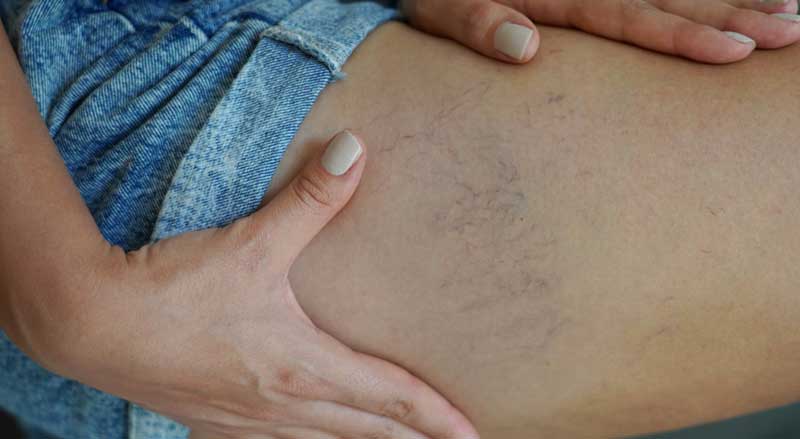Spider veins are small veins that appear in clusters, resembling spiderwebs or tree branches.
While spider veins are not a medical concern, many individuals treat them for cosmetic reasons.
Are you wondering why you are suddenly seeing spider veins? Find the answers here.
About Spider Veins
Spider veins typically appear in clusters near the skin’s surface, commonly on the ankles, thighs, calves, and sometimes on the face. These damaged blood vessels usually appear in shades of red and blue.
Some visible spider veins are considered normal and may be expected if you have a light skin tone.
However, certain factors affecting your body may make these veins even more noticeable.
People often confuse spider veins and reticular veins. Here’s an informative article explaining the differences between the two conditions.
Reasons Veins Suddenly Become More Obvious
If spider veins suddenly appear, it’s usually because the veins are experiencing added pressure.
When veins experience more pressure, they expand in size and become more noticeable. When the pressure is reduced, the vein becomes less evident but is still under the skin.
Unfortunately, spider veins are almost always permanent—except in some instances involving pregnancy or certain medical conditions. In fact, many spider veins worsen over time.
Let’s explore the potential causes of sudden spider vein appearance and learn how to slow down the development of new veins.
Getting Older
Age is a significant factor in the appearance of spider veins for three reasons:
- As we age, we experience reduced collagen production, resulting in thinner skin and making our veins more visible.
- Gradual loss of fatty tissue makes veins more visible.
- Aging veins lose elasticity and weaken, which causes blood flow problems and results in spider veins.
Standing or Sitting for a Long Time
Prolonged periods of sitting or standing cause blood to pool in the legs. This increased pressure expands the veins and makes them more visible.
Try to change your position frequently to relieve leg pressure and encourage better circulation.
Injury to a Leg
An injury to the leg that temporarily restricts movement can cause spider veins to develop. If you can’t move your legs during recovery, keep your legs elevated.
If your leg sustains an injury, it can temporarily restrict movement, causing spider veins to develop.
If you are injured and can’t move your legs during recovery, keeping your legs elevated is essential.
Sudden Weight Gain or Obesity
Being overweight puts additional pressure on your veins. Increased pressure weakens the valves and walls of the veins, leading to the appearance of more prominent and visible veins.
Maintaining a healthy weight can aid in preventing circulation issues and stop new spider veins from forming.
Some individuals may experience weight fluctuations.
Although weight gain can alleviate pressure on the legs, it’s important to note that the veins themselves may not completely disappear.
Being Outside in Hot Weather
Hot weather can cause your veins to enlarge due to increased blood flow. Eventually, they will appear less prominent as the heat decreases.
Excessive sun exposure can also lead to the visibility of tiny veins beneath the skin.
Sunburn and UV rays cause inflammation, bringing the blood vessels closer to the skin’s surface, particularly for those with fair skin.
Additionally, prolonged sun exposure can also break down collagen in the skin, making veins more noticeable.
You can prevent this by wearing a sun-protective hat, sunglasses, and sunscreen when you spend time outside. Another alternative is to seek shade.
Vigorously Exercising
During vigorous exercise, your blood pressure naturally increases, causing your veins to expand. Understanding this process can help you feel more informed and less alarmed about the temporary visibility of your veins.
Weight-bearing exercises also pressure veins, causing them to develop a more defined appearance.
Experiencing Hormonal Changes
Puberty, birth control pills, pregnancy, and menopause can all cause veins to appear for the first time.
As hormonal shifts occur, blood flow increases, causing pressure and expansion, ultimately making veins more visible.
During pregnancy, the increase in estrogen levels and the expansion of blood volume in the body put pressure on the veins. This, combined with reduced blood flow from the legs to the pelvis, causes strain on the vein walls and the development of spider veins.
Spider veins from pregnancy can disappear on their own after several months.
Smoking and Drinking
Both drinking and smoking can cause veins to become more visible.
Alcohol increases heart rate, leading to more blood filling the veins and making them more visible. Prolonged excessive drinking can weaken veins, making them appear even more prominent.
Smoking introduces chemicals into the bloodstream, reducing oxygen and thickening the blood. This damages the vein walls, causing the veins to bulge and become more visible.
Wearing Tight Clothing
Wearing clothing that is too tight around the waist or legs can cause veins to become more visible from restricted blood flow and higher blood pressure.
It’s In Your DNA!
Genetics significantly influences the development of visible veins.
If you have close relatives with spider veins, chances are high that you will also have them.
When to See a Doctor
If a spider vein or other vein shows any of these signs, it may indicate a blood clot:
- Redness
- Warmth
- Tenderness to the touch
- Bleeding
- Discoloration around the vein accompanied by a rash or sore.
If you experience any of these symptoms, please seek medical attention immediately.
Treatments for Spider Veins
Fortunately, there are in-office treatments available that can effectively remove unwanted spider veins.
Sclerotherapy is a minimally invasive procedure that does not require anesthesia. It is recognized as the most effective treatment for eliminating spider veins and reticular veins.
Varithena™ is an incision-free treatment that usually takes less than 10 minutes. It is often used in ultrasound-guided treatments of spider veins and varicose veins.
Both Sclerotherapy and Varithena are highly effective in the treatment of spider veins.
Some veins and areas will need to be re-treated. A recurrence of the same vein is rare. Proper injection technique and patient compliance with post-treatment instructions will ensure the best results.
Here’s why some people ask if spider veins come back after treatment.
Read more about treating and preventing spider veins on the ankles.
Feel free to contact The New Jersey Vein and Vascular Center in Randolph, NJ to take the first step towards a healthier you with a vein screening and personalized treatment plan.






